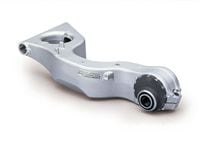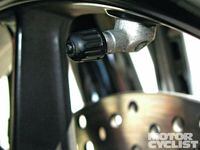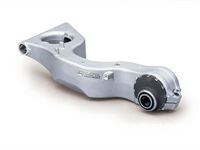Got A Question For Answers? Send It To mcmail@sorc.com
Saving Face
Q: A friend of mine had a blackout the other day and drove his motorcycle at about 20 mph straight into a tree. He was wearing an open-face helmet. His face, as you can imagine, received significant damage. However, a retired state trooper on the scene said an interesting thing: "It's lucky he wasn't wearing a full-face helmet because his face absorbed the blow, preventing his neck from snapping back. If he had been wearing a full-face helmet, it would have ricocheted off the tree and snapped his neck like a twig." Is the trooper correct? Are full-face helmets more dangerous than open-face helmets?
Fred Parmenter
Medfield, MA
A: _According to Dave Thom, a senior consultant specializing in protective headgear, safety and research at Collision and Injury Dynamics in El Segundo, California, the short answer is no. "I'm happy to tell you that retired Massachusetts State Troopers are apparently not good sources for head-injury bio-mechanics and helmet advice," Thom says. "He doesn't have any idea what he's talking about. I love to ride my dirtbike in the woods and my streetbike on the street, and if I were to stick my face into a tree or utility pole, I'd much rather be wearing a helmet with full facial coverage than anything else. We're talking about a modern full-face helmet, with a substantial chin bar structure lined with substantial padding—typically the same EPS foam that protects the rest of your head. But give your trooper some credit: There is a bit of truth to the notion that fractured facial bones help protect the brain; a helmet just does a much better job without the pain and disfigurement. An impact to your bare skull is more likely to cause a brain injury than an identical impact to your unprotected face because the facial structure will fracture, absorbing energy and providing some protection, albeit painful.
“As far as ‘snapping his neck like a twig,’ helmets have very little to do with neck injuries. When they do it’s usually a protective one, since the helmet is absorbing the impact energy that would a) hurt your head and, b) be passed through your injured head to your neck.” _
Put A Cap On It!
Q: My know-it-all brother just read me the riot act because the valve stem caps on my 1999 Honda CBR600RR are missing. To tell you the truth, I don't even know how long they've been missing. That doesn't seem like a big deal to me—or is it?
Randy Okuno
Reno, NV
A: Missing valve stem caps can be a bigger deal than you think. Aside from keeping road grime from getting into the Schrader valve underneath and mucking things up, properly installed caps help keep air from getting out of your tires. That's not a big deal when the bike is stopped or moving slowly, assuming you check pressure regularly. But there's enough centrifugal force acting on that valve at speed to compress the valve's internal spring, allowing the air inside to escape. If the cap is in place, there's nothing to worry about. Otherwise, the faster you go, the more air you're likely to lose. If the valve fails without a cap, you're in a world of hurt. So spend a couple of bucks on some nice steel caps with slotted tops that will let you keep the valve internals tight. You'll have one less thing to worry about, and so will your brother.
One-Sided
Q: What's the advantage of using a single-sided swingarm over more conventional double-sided designs? Where did the idea come from?
A: A single-sided swingarm makes removing a motorcycle's rear wheel as easy as pulling one off the family sedan. No worries about alignment when you put it back on, either. Chain adjustments are quicker and easier as well. It takes some elegant engineering to make such a design work. It requires all the longitudinal rigidity of a dual-arm design and enough torsional stiffness to keep torque applied to that offset axle from twisting the whole thing into an aluminum pretzel. Effective single-sided swingarm designs started showing up in the late 1940s and early '50s on bikes like Carlo Guzzi's 150cc Galletto. BMW's single-sided Monolever shaft-drive setup debuted on the 1980 R80G/S. Extinct French petroleum giant ELF pioneered a host of innovative chassis designs for Grand Prix and World Endurance racing, including a patented S-shaped rear suspension design that Honda leased the rights to produce in '87. The Pro-Arm came stateside on Honda's '88 Hawk GT and the '90 RC30 and a succession of VFRs. BMW, Ducati, MV Agusta, Triumph and others have used the idea on various models.














/cloudfront-us-east-1.images.arcpublishing.com/octane/FZXHNOQRNVA3BIDWAF46TSX6I4.jpg)
/cloudfront-us-east-1.images.arcpublishing.com/octane/JRSFLB2645FVNOQAZCKC5LNJY4.jpg)
/cloudfront-us-east-1.images.arcpublishing.com/octane/ITNLTIU5QZARHO733XP4EBTNVE.jpg)
/cloudfront-us-east-1.images.arcpublishing.com/octane/VZZXJQ6U3FESFPZCBVXKFSUG4A.jpg)
/cloudfront-us-east-1.images.arcpublishing.com/octane/QCZEPHQAMRHZPLHTDJBIJVWL3M.jpg)
/cloudfront-us-east-1.images.arcpublishing.com/octane/HXOUJXQWA5HBHGRO3EMJIGFMVI.jpg)

/cloudfront-us-east-1.images.arcpublishing.com/octane/3TIWWRV4JBBOLDVGRYECVVTA7Y.jpg)
/cloudfront-us-east-1.images.arcpublishing.com/octane/KIX5O23D5NAIBGFXBN3327DKZU.jpg)
/cloudfront-us-east-1.images.arcpublishing.com/octane/7GJYDUIPXRGMTMQKN6ONYOLBOU.jpg)
/cloudfront-us-east-1.images.arcpublishing.com/octane/MUQLOVLL2ZDGFH25ILABNBXKTI.jpg)
/cloudfront-us-east-1.images.arcpublishing.com/octane/TNOU5DNE2BC57MFPMGN2EIDXAM.jpg)
/cloudfront-us-east-1.images.arcpublishing.com/octane/GTCXACQGJ5HAPDTGWUQKDEH44E.jpg)
/cloudfront-us-east-1.images.arcpublishing.com/octane/S35YGSEMEZB4BLTDJTSZPF4GLA.jpg)
/cloudfront-us-east-1.images.arcpublishing.com/octane/5UOT6HPX2JFMRJAX6EH45AR4MQ.jpg)
/cloudfront-us-east-1.images.arcpublishing.com/octane/OKWOJWAKP5EP3OACCRRWPCIX2Q.jpg)
/cloudfront-us-east-1.images.arcpublishing.com/octane/2WF3SCE3NFBQXLDNJM7KMXA45E.jpg)
/cloudfront-us-east-1.images.arcpublishing.com/octane/G4MG6OUCJNBSHIS2MVVOTPX65E.jpg)
/cloudfront-us-east-1.images.arcpublishing.com/octane/IIGGWFOTOJGB7DB6DGBXCCMTDY.jpg)
/cloudfront-us-east-1.images.arcpublishing.com/octane/QSTCM6AVEZA5JJBUXNIQ3DSOF4.jpg)
/cloudfront-us-east-1.images.arcpublishing.com/octane/U4I7G625B5DMLF2DVIJDFZVV6M.jpg)
/cloudfront-us-east-1.images.arcpublishing.com/octane/B6XD6LS6IVCQPIU6HXDJSM3FHY.jpg)
/cloudfront-us-east-1.images.arcpublishing.com/octane/ICL63FEDDRDTTMINYICCEYGMDA.jpg)
/cloudfront-us-east-1.images.arcpublishing.com/octane/FCGZHQXRBZFLBAPC5SDIQLVF4I.jpg)